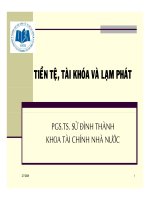Bài giảng tiền tệ và ngân hàng
Bạn đang xem bản rút gọn của tài liệu. Xem và tải ngay bản đầy đủ của tài liệu tại đây (422.29 KB, 33 trang )
COURSE
MONEY AND BANKING
2006
Lecturer: Dr Karel Jansen
Part I The Banking System:
•
Financial Markets
•
Financial Intermediation and Development
•
Banking as Risk Management
•
Financial Fragility and Financial Crisis
•
Part II Money in the economy: monetary theory and monetary
policy
•
Money Supply and Money Demand
•
Monetary Theory: Money and the Real Sector
•
Monetary Policy
Part III Financial development and banking in Vietnam
•
The Banking System during Transition in Viet Nam
Financial markets
•
Introduction
•
Money
•
Overview of financial markets
Some definitions
•
Money
Money = token of value which is generally acceptable in
the purchase and sale of goods, services and assets and
the settlement of debts
•
Financial markets
Financial markets = markets in which banks and other
financial institutions provide a variety of financial
services and products which facilitate the production,
distribution and consumption of goods and services as
well as the distribution of income and, crucially,
entitlements to income
Some definitions (contd)
•
Financial market innovation
Financial market innovation = the development of new
services and products and new technologies and
processes for the delivery of these new services and
products
•
Financial market regulation
Financial market regulation = the statutory constraints
on the activities of financial market institutions
•
Monetary policy
Monetary policy = policies designed to influence
macroeconomic aggregates by influencing the quantity or
price of money in the economy
Objectives
•
Introduction to certain
technical details
technical details pertaining to
money, financial markets, institutions, instruments,
developments and policies
•
Appreciation of different theoretical perspectives pertaining
to the
nature and behaviour
nature and behaviour of financial markets and
determination
determination of prices in these markets
•
Understanding the conduct and effectiveness of
monetary
monetary
policy
policy in the context of macroeconomic management and
policy issues pertaining to the development and
regulation
regulation
of financial markets
Money: what is it?
Money = value par excellance
Exchangeable
Exchangeable with all;
•
Goods and services
•
Assets
Acceptable
Acceptable in settlement of any
debt
Money: functions
•
means of payment,
•
settlement of debt,
•
store of value,
•
standard of price and unit of
account
Money: characteristics
•
General acceptability
•
Transportability
•
Divisibility
•
Stability in value
•
Liquidity
Money: historical development
•
Important consumables, including live
animals
•
Various luxury items – pelts, hides,
cloth, trinkets, etc
•
Metals
•
Paper
•
Electronic money
Money: measures of money
•
Coins and notes (M0)
•
M0 + demand deposits (M1)
•
M1 + savings and fixed deposits (M2)
•
M2 + deposits with other deposit taking
institutions (M3)
•
M3 plus short-term government debt
instruments (Mx), etc
Financial markets: overview
Financial
markets
Money market (1)
Capital market (2)(3)
Foreign exchange
market (4)
Financial derivatives
markets (5)
Monetary
authority (6)
Financial markets: the
money market
•
Nature and behaviour of money
markets
•
Determination of money market
rates









